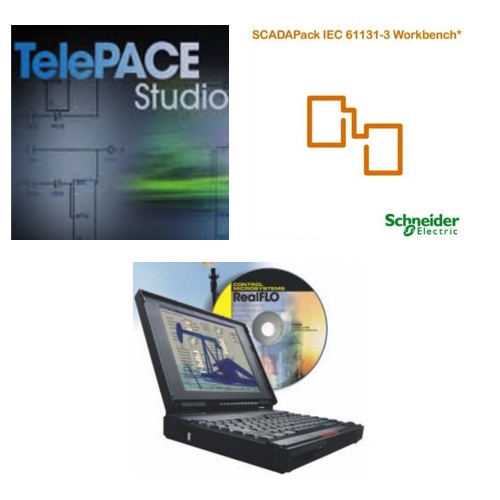SCADAPack PLC Programming Software

Telepace Studio is used for developing, debugging and downloading ladder logic code to SCADAPack Smart RTUs. It allows for both online and offline code development and provides local and remote access to the process by utilizing intranet and Internet technologies. It also provides diagnostic and configuration tools, including an integrated firmware loader, as well as custom functions for SCADA-specific applications. Telepace Studio allows engineers to quickly develop digital and analog sequences, create data logs, configure PID process control, calculate flow totals and perform communication functions.
Realflo Flow Computer is a software solution that works with SCADAPack Smart RTUs to provide gas and liquid flow measurement for applications such as allocation measurement, production optimization, well test and well pad control. The SCADAPack Smart RTU is a powerful platform that, with the Realflo Flow Computer, can support up to 20 flow runs with IEC 61131-3 logic, to perform monitoring and control tasks for applications such as tank monitoring, production optimization and well pad and flow control.The Realflo Flow Computer can report information using Modbus, Enron Modbus and DNP3 protocols.
SCADAPack IEC 61131-3 Workbench and Utilities is used for developing, debugging and downloading SCADAPack Smart RTU logic code. The Workbench is based on the Visual Studio framework and installs directly on Windows operating systems. The Drag & Drop graphical programming supports import, edit and debug of the three most popular IEC 61131-3 languages: Ladder Diagram (LD), Functional Block Diagram (FBD) and Structured Text (ST).
SCADA: Learning the Basics
Supervisory Control and Data Acquisition (SCADA) systems are a combination of both hardware and software that allows monitoring of various devices that provide information about specific environments or processes. This information is transmitted through logic controllers, or other smart devices, and is sent to software interfaces known as an HMI, where the information is displayed in a way that individuals can read and interpret the data. SCADA is not only used for monitoring, it is also used for control. Through SCADA, it is possible to manipulate, move, or change the state of certain devices on the network. For example, it is possible to initiate a command through the HMI software that will energize or de-energize a solenoid valve, thus changing its state. In most scenarios, there are dozens, hundreds, or even thousands of points throughout a location or multiple locations that are being monitored and controlled through SCADA. SCADA systems can be found in many different industries such as telecommunications, water and wastewater, energy, oil and gas refining and transportation. These systems can be used to monitor and control only a few simple points, or can be used in massive energy plants where tens of thousands of data points are being interpreted and controlled every minute.
Hardware used in SCADA systems include:
- PLCs, which can act as a bridge between the hardware and software, as well as providing data transmission and network communications.
- Field monitoring and control devices, such as limit switches, temperature transmitters, pressure transmitters, solenoid valves, chemical monitoring devices and motor starters.
Software used in SCADA systems include:
- HMI or Human Machine Interface software receives data throughout the system and organizes it in a way that can be easily interpreted. It can also provide control based on the information it receives.

